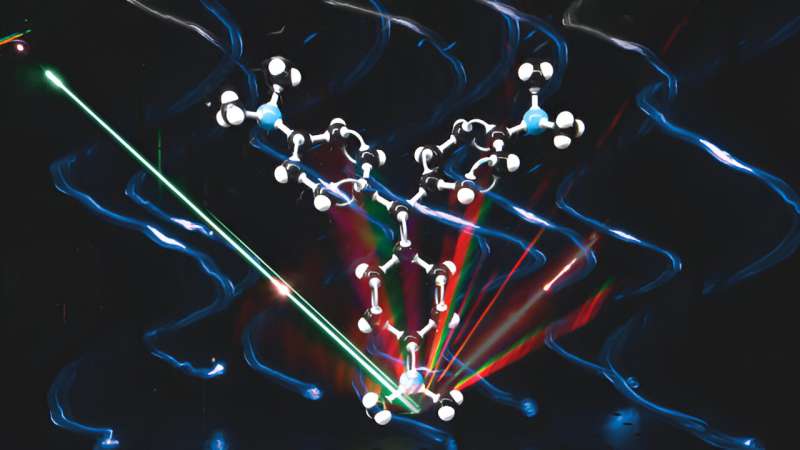
Using conventional testing techniques, it can be challenging—sometimes impossible—to detect harmful contaminants such as nano-plastics, air pollutants and microbes in living organisms and natural materials. These contaminants are sometimes found in such tiny quantities that tests are unable to reliably pick them up.
This may soon change, however. Emerging nanotechnology (based on a “twisted” state of light) promises to make it easier to identify the chemical composition of impurities and their geometrical shape in samples of air, liquid and live tissue.
An international team of scientists led by physicists at the University of Bath is contributing toward this technology, which may pave the way to new environmental monitoring methods and advanced medicines. Their work is published in the journal Advanced Materials.
The emerging chemical-detection technique is based on a light-matter interaction known as the Raman effect. The Raman effect occurs when a material that is illuminated at a certain color of light scatters and changes the light into a multitude of slightly different colors. It essentially produces a mini-rainbow that is dependent on how atoms within materials vibrate.
Measuring the colors of the Raman rainbow reveals individual atomic bonds because molecular bonds have distinct vibrational patterns. Each bond within a material produces its own unique color change from that of the illumination. Altogether, the colors in the Raman rainbow serve to detect, analyze and monitor the chemical composition (chemical bonds) of complex molecules, such as those found within mixtures of environmental pollutants.
“The Raman effect serves to detect pesticides, pharmaceuticals, antibiotics, heavy metals, pathogens and bacteria. It’s also used for analyzing individual atmospheric aerosols that impact human health and the climate,” said Dr. Robin Jones from the Department of Physics at Bath, who is the first-author of the study.
Harmful pollutants
Expanding, co-author Professor Liwu Zhang from the Department of Environmental Science at Fudan University in China said, “Aquatic pollutants, even in trace amounts, can accumulate in living organisms through the biological chain. This poses a threat to human health, animal welfare and wildlife. Generally, it is really hard to know exactly what the chemical composition of complex mixtures are.”
Professor Ventsislav Valev from Bath, who led the study, added, “Understanding complex, potentially harmful pollutants in the environment is necessary, so that we can learn how to break them down into harmless components. But it is not all about what atoms they are made of. The way the atoms are arranged matters a lot—it can be decisive for how molecules act, especially within living organisms.
“Our work aims to develop new ways in which the Raman effect can tell us about the way atoms are arranged in space and now we have taken an important technological step using tiny helix shaped antennas made of gold.”
The Raman effect is very weak—only one out of 1,000,000 photons (light particles) undergo the color change. In order to enhance it, scientists use miniature antennas fabricated at the nanoscale that channel the incident light into the molecules. Often these antennas are made of precious metals and their design is limited by nanofabrication capabilities.
The team at Bath used the smallest helical antennas ever employed: their length is 700 times smaller than the thickness of a human hair and the width of the antennas is 2,800 times smaller. These antennas were made from gold by scientists in the team of Professor Peer Fischer at the University of Stuttgart in Germany.
“Our measurements show these helical antennas help to get a lot of Raman rainbow photons out of molecules,” said Dr. Jones. “But more importantly, the helical shape enhances the difference between two types of light that are often used to probe the geometry of molecules. These are known as circularly polarized light.
“Circularly polarized light can be left-handed or right-handed and our helices can, basically, handshake with light. And because we can make the helices twist to the left or to the right, the handshake with light that we devised can be both with left or right hands.”
“While such handshakes have been observed before, the key advance here is that we demonstrate for the first time that it is felt by molecules, as it affects their Raman rainbow. This is an important step that will allow us to distinguish efficiently and reliably between left- and right-handed molecules, first in the lab and then in the environment.”
Crystal violet
In order to demonstrate that the new handshaking between light and antennas could be transmitted to molecules, the researchers made use of molecules—crystal violet—that are unable to ‘handshake’ with light by themselves. Yet these molecules behaved as if they could perform this function, expressing the ‘handshaking’ ability of gold nanohelices to which they were attached.
“Another important aspect of our work here is that we worked with two industrial partners,” said Professor Valev. “VSParticle produce standard nanomaterials for measuring Raman light. Having common standards is really important for researchers around the world to be able to compare results.”
He added, “Our industrial partner Renishaw PLC is a world-leading manufacturer of Raman spectroscopy and microscopy equipment. Such partnerships are essential, so that new technology can move out of the labs and into the real-world, where the environmental challenges are.”
Building on this work, the team is now working on developing more advanced forms of Raman technologies.
More information:
Robin R. Jones et al, Dense Arrays of Nanohelices: Raman Scattering from Achiral Molecules Reveals the Near‐Field Enhancements at Chiral Metasurfaces, Advanced Materials (2023). DOI: 10.1002/adma.202209282
Provided by
University of Bath
Citation:
New nanotech identifies chemical composition and structure of impurities in air, liquid and living tissue (2023, July 31)
retrieved 1 August 2023
from https://phys.org/news/2023-07-nanotech-chemical-composition-impurities-air.html
This document is subject to copyright. Apart from any fair dealing for the purpose of private study or research, no
part may be reproduced without the written permission. The content is provided for information purposes only.










